All of the prophecies of the Eucharist are fulfilled by Jesus. He is the Lamb of God sacrificed for us. We partake in His sacrifice through the Mass and enter into the new and everlasting covenant when we receive the Eucharist. God’s love for us is beyond our comprehension, but we can see this amazing and incredible boundless love perfectly given in the Eucharist.
Scripture, starting in Genesis, is the story of God preparing us and leading us to total unity with Him. Much of the story is about how we reject this plan, over and over again, but God never gives up on us. He loves us so much. He uses everything that is and everything that happens to lead us to Him. Even our rejection of Him in all our sinful actions is used to try to get us turn back.
 God’s goal of unity between us and God is realized in Heaven, but it is also on earth. We are called by God to receive God’s love, and His very being, into us. This is given spiritually but also physically. In the Eucharist, we receive the body, blood, soul and divinity of Jesus.
God’s goal of unity between us and God is realized in Heaven, but it is also on earth. We are called by God to receive God’s love, and His very being, into us. This is given spiritually but also physically. In the Eucharist, we receive the body, blood, soul and divinity of Jesus.
The fulfillment of God’s plan, the gift of the Eucharist, gets started with the Incarnation. God must become man in order to give His flesh and blood. The fulfillment is completed with the gift of the Eucharist, started in the upper room at the Last Supper and completed on Calvary when Jesus pronounces, “It is finished.”
This is not the end, though. The Eucharist is a perpetual offering, given from the rising of the sun to its setting, and offered everywhere. The blood of Jesus is poured out at every Mass, and each of us has the opportunity to enter into this sacrifice and covenant every bit as fully as the Apostles at the Last Supper.
Scripture passages showing the fulfillment of the Eucharistic Promise:
- Luke 2:4-7 – Incarnation
- John 1:26-29 – Behold the Lamb of God
- Matthew 26:17-20 – Jesus celebrates the Passover
- Institution Narratives
- 1 Corinthians 11:23-26 – Institution Narrative
- Matthew 26:26-29 – Institution Narrative
- Mark 14:17-25 – Institution Narrative
- Luke 22:15-20 – Institution Narrative
- John 19:18-35 – Crucifixion
- Luke 24:15-16, 25-35 – Journey to Emmaus
- Matthew 28:18-20 – I am with you always
- Acts 2:38-42 – They devoted themselves to the breaking of the bread
- Acts 20:6-12 – Mass in Troas
Luke 2:4-7 – Incarnation
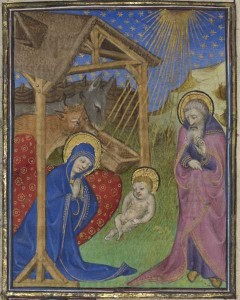
And Joseph too went up from Galilee from the town of Nazareth to Judea, to the city of David that is called Bethlehem, because he was of the house and family of David, to be enrolled with Mary, his betrothed, who was with child. While they were there, the time came for her to have her child, and she gave birth to her firstborn son. She wrapped him in swaddling clothes and laid him in a manger, because there was no room for them in the inn.
The fulfillment of the gift of the Eucharist starts with the Incarnation. If the Son never became man, there could be no Eucharist. Jesus needed a body to give us His flesh.
The Messiah was prophesied to be born in the city of David. Bethlehem means house of bread. It is very fitting that the Bread of Life was born in the house of bread.
Jesus was laid in a manger. A manger is a feeding trough for the animals. Our Lord, who gives us His body and blood to eat and drink, was laid in a feeding trough at His birth.
John 1:26-29 – Behold the Lamb of God
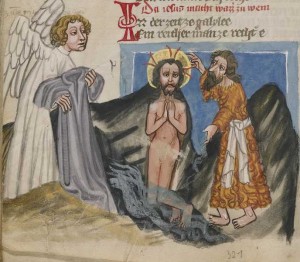
John answered them, “I baptize with water; but there is one among you whom you do not recognize, the one who is coming after me, whose sandal strap I am not worthy to untie.” This happened in Bethany across the Jordan, where John was baptizing. The next day he saw Jesus coming toward him and said, “Behold, the Lamb of God, who takes away the sin of the world.”
Before Jesus starts His public ministry, He goes to John the Baptist to be baptized. Our Lord had no need for baptism. He was without sin and had nothing to repent. He went to be anointed.
When John sees Jesus, he explains that Jesus is the Lamb of God. The implications of this are enormous. The lamb was predicted by Abraham, and the lamb an integral element is Israel’s deliverance from Egypt. John is saying that Jesus is the fulfillment of both of these.
Jesus is the Son offered in sacrifice. He is the pure offering, a lamb without blemish, offered in sacrifice. He is the sacrifice of atonement that takes away sin and restores the relationship between God and His people.
In the Passover, the lamb had to be eaten. The people needed to participate personally in the sacrifice. Jesus, as the Lamb of God sacrificed for us, had to give His flesh for us to consume so that we could personally enter into His sacrifice. God’s love for us is infinite, and the Eucharist is the ultimate sign of this love.
Matthew 26:17-20 – Jesus celebrates the Passover
On the first day of the Feast of Unleavened Bread, the disciples approached Jesus and said, “Where do you want us to prepare for you to eat the Passover?” He said, “Go into the city to a certain man and tell him, ‘The teacher says, “My appointed time draws near; in your house I shall celebrate the Passover with my disciples.”‘” The disciples then did as Jesus had ordered, and prepared the Passover. When it was evening, he reclined at table with the Twelve.
The Feast of Unleavened Bread and the Passover were signs pointing to Jesus and Eucharist. It is fitting that our Lord celebrated these when He gave us His body, blood, soul and divinity in the Holy Eucharist.
Institution Narratives
The institution of the Eucharist occurs in four places. St. Paul is the first to write his account in the letter to the Corinthians. Matthew, Mark and Luke follow with their accounts. Paul indicates that his account was provided to him directly from Jesus. The Eucharist is so important that Jesus instructed Paul personally on it.
In all four accounts, the language is declarative and unambiguous. Jesus is clear in stating that the Eucharist is His body and blood.
1 Corinthians 11:23-26 – Institution Narrative
For I received from the Lord what I also handed on to you, that the Lord Jesus, on the night he was handed over, took bread, and, after he had given thanks, broke it and said, “This is my body that is for you. Do this in remembrance of me.” In the same way also the cup, after supper, saying, “This cup is the new covenant in my blood. Do this, as often as you drink it, in remembrance of me.” For as often as you eat this bread and drink the cup, you proclaim the death of the Lord until he comes.
Matthew 26:26-29 – Institution Narrative
While they were eating, Jesus took bread, said the blessing, broke it, and giving it to his disciples said, “Take and eat; this is my body.”Then he took a cup, gave thanks, and gave it to them, saying, “Drink from it, all of you, for this is my blood of the covenant, which will be shed on behalf of many for the forgiveness of sins. I tell you, from now on I shall not drink this fruit of the vine until the day when I drink it with you new in the kingdom of my Father.”
Mark 14:17-25 – Institution Narrative
When it was evening, he came with the Twelve. And as they reclined at table and were eating, Jesus said, “Amen, I say to you, one of you will betray me, one who is eating with me.” They began to be distressed and to say to him, one by one, “Surely it is not I?” He said to them, “One of the Twelve, the one who dips with me into the dish. For the Son of Man indeed goes, as it is written of him, but woe to that man by whom the Son of Man is betrayed. It would be better for that man if he had never been born.” While they were eating, he took bread, said the blessing, broke it, and gave it to them, and said, “Take it; this is my body.” Then he took a cup, gave thanks, and gave it to them, and they all drank from it. He said to them, “This is my blood of the covenant, which will be shed for many. Amen, I say to you, I shall not drink again the fruit of the vine until the day when I drink it new in the kingdom of God.”
Luke 22:15-20 – Institution Narrative
He said to them, “I have eagerly desired to eat this Passover with you before I suffer, for, I tell you, I shall not eat it (again) until there is fulfillment in the kingdom of God.” Then he took a cup, gave thanks, and said, “Take this and share it among yourselves; for I tell you (that) from this time on I shall not drink of the fruit of the vine until the kingdom of God comes.” Then he took the bread, said the blessing, broke it, and gave it to them, saying, “This is my body, which will be given for you; do this in memory of me.” And likewise the cup after they had eaten, saying, “This cup is the new covenant in my blood, which will be shed for you.”
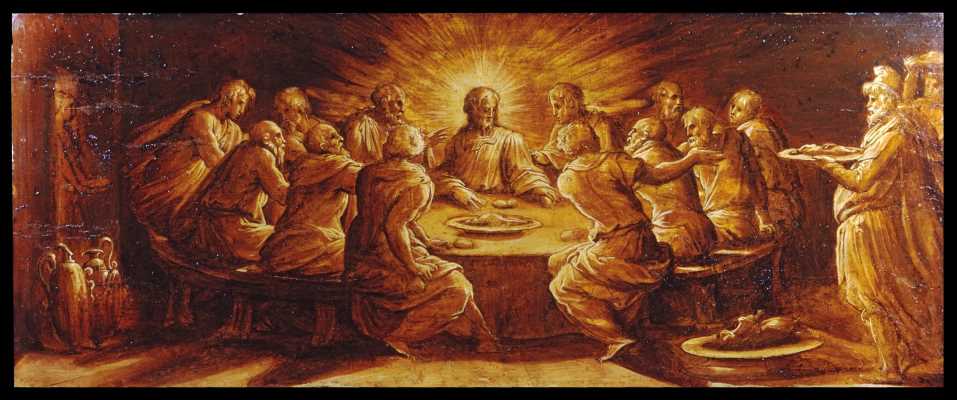
John 19:18-35 – Crucifixion
There they crucified him, and with him two others, one on either side, with Jesus in the middle. Pilate also had an inscription written and put on the cross. It read, “Jesus the Nazorean, the King of the Jews.” Now many of the Jews read this inscription, because the place where Jesus was crucified was near the city; and it was written in Hebrew, Latin, and Greek. So the chief priests of the Jews said to Pilate, “Do not write ‘The King of the Jews,’ but that he said, ‘I am the King of the Jews.'” Pilate answered, “What I have written, I have written.” When the soldiers had crucified Jesus, they took his clothes and divided them into four shares, a share for each soldier. They also took his tunic, but the tunic was seamless, woven in one piece from the top down. So they said to one another, “Let’s not tear it, but cast lots for it to see whose it will be,” in order that the passage of scripture might be fulfilled (that says): “They divided my garments among them, and for my vesture they cast lots.” This is what the soldiers did. Standing by the cross of Jesus were his mother and his mother’s sister, Mary the wife of Clopas, and Mary of Magdala. When Jesus saw his mother and the disciple there whom he loved, he said to his mother, “Woman, behold, your son.” Then he said to the disciple, “Behold, your mother.” And from that hour the disciple took her into his home. After this, aware that everything was now finished, in order that the scripture might be fulfilled, Jesus said, “I thirst.” There was a vessel filled with common wine. So they put a sponge soaked in wine on a sprig of hyssop and put it up to his mouth. When Jesus had taken the wine, he said, “It is finished.” And bowing his head, he handed over the spirit. Now since it was preparation day, in order that the bodies might not remain on the cross on the sabbath, for the sabbath day of that week was a solemn one, the Jews asked Pilate that their legs be broken and they be taken down. So the soldiers came and broke the legs of the first and then of the other one who was crucified with Jesus. But when they came to Jesus and saw that he was already dead, they did not break his legs, but one soldier thrust his lance into his side, and immediately blood and water flowed out. An eyewitness has testified, and his testimony is true; he knows that he is speaking the truth, so that you also may (come to) believe.
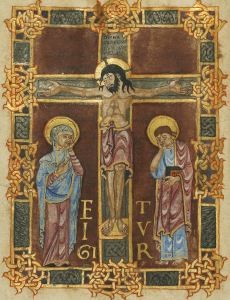 The Last Supper and Crucifixion are two parts of the same event. They are not separate. The Last Supper is how we participate in Jesus’ Crucifixion that is His sacrifice for us. Separate, the Last Supper and the Crucifix both lose their meaning. There are several subtle details that John provides us that make it clear that the Crucifixion if the consummation of the sacrifice offered by Christ at the Last Supper.
The Last Supper and Crucifixion are two parts of the same event. They are not separate. The Last Supper is how we participate in Jesus’ Crucifixion that is His sacrifice for us. Separate, the Last Supper and the Crucifix both lose their meaning. There are several subtle details that John provides us that make it clear that the Crucifixion if the consummation of the sacrifice offered by Christ at the Last Supper.
Jesus wears a seamless linen garment. This is important because priestly garments had to be seamless. Jesus carries the cross and is led to His crucifixion wearing the priestly vestment typical of liturgical celebrations. The crucifixion is liturgy with Jesus the High Priest offering the sacrifice.
At the Last Supper, Jesus says He will not drink wine again until He does so in the Kingdom of God. This leaves the Last Supper open-ended. We are awaiting Jesus to drink His final cup of wine. He does exactly this on the cross. In His last act, He says “I thirst.” He is given wine to drink, and He says “It is finished” as He dies.
This concludes His sacrifice started in the upper room. With this conclusion, the Eucharist is complete. It is a total gift of His body and blood. To reinforce how He pours out His blood for us, His death is followed by the soldier piercing Him with blood and water pouring from His side. He gives every drop of His blood for us.
Luke 24:15-16, 25-35 – Journey to Emmaus
And it happened that while they were conversing and debating, Jesus himself drew near and walked with them, but their eyes were prevented from recognizing him. And he said to them, “Oh, how foolish you are! How slow of heart to believe all that the prophets spoke! Was it not necessary that the Messiah should suffer these things and enter into his glory?” Then beginning with Moses and all the prophets, he interpreted to them what referred to him in all the scriptures. As they approached the village to which they were going, he gave the impression that he was going on farther. But they urged him, “Stay with us, for it is nearly evening and the day is almost over.” So he went in to stay with them. And it happened that, while he was with them at table, he took bread, said the blessing, broke it, and gave it to them. With that their eyes were opened and they recognized him, but he vanished from their sight. Then they said to each other, “Were not our hearts burning (within us) while he spoke to us on the way and opened the scriptures to us?” So they set out at once and returned to Jerusalem where they found gathered together the eleven and those with them who were saying, “The Lord has truly been raised and has appeared to Simon!” Then the two recounted what had taken place on the way and how he was made known to them in the breaking of the bread.
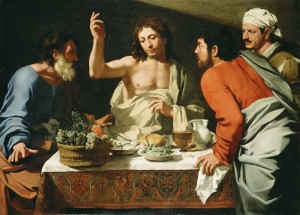 On Easter Sunday, the day of the Resurrection, Jesus chooses to spend the day celebrating Mass. The disciples’ experience on the way to Emaus is liturgical. It starts with the Liturgy of the Word. Jesus teaches the disciples the Word of God, opening the Scriptures to them.
On Easter Sunday, the day of the Resurrection, Jesus chooses to spend the day celebrating Mass. The disciples’ experience on the way to Emaus is liturgical. It starts with the Liturgy of the Word. Jesus teaches the disciples the Word of God, opening the Scriptures to them.
They say their hearts burned as Jesus taught them, but they could not recognize Jesus. This is an important lesson. The Scriptures are extremely important, but Scripture alone is not sufficient. To encounter Jesus, we need more. If two disciples who knew Jesus well could not recognize Him as He walked with them and opened the Scriptures to them, how can we recognize Him from just reading the Bible?
Then, just like every Mass today, they moved into the Liturgy of the Eucharist. At the meal, Jesus does what He commanded us to do. He consecrated the bread, changing it into His body. It is through the Eucharist that the disciples’ eyes are opened. Although Jesus was previously visible as He walked with them, He was hidden from the disciples. Then, He was revealed to them in the Eucharist.
It is through the Eucharist that we truly encounter Jesus.
Matthew 28:18-20 – I am with you always
Then Jesus approached and said to them, “All power in heaven and on earth has been given to me. Go, therefore, and make disciples of all nations, baptizing them in the name of the Father, and of the Son, and of the holy Spirit, teaching them to observe all that I have commanded you. And behold, I am with you always, until the end of the age.”
Jesus’ final words before ascending are a promise that He will always be with us. It is easy to see this purely spiritually. Jesus, in His divinity, is God and is everywhere. Of course, He is with us always. Although this is absolutely true, there is more. In Jesus’ humanity, He gives His body and blood to us in the Eucharist under the appearance of bread and wine. He has never left us. In His Sacrament of Love, our Lord is with us always. We can find Him, body, blood, soul and divinity, in every Mass and in every tabernacle.
If two cherubim with fiery revolving swords guarded the way to the Tree of Life in Genesis, how much must the angels bow before the Son of God in the Eucharist? If we truly appreciated this Sacrament for what it is, we would be terrified to approach, awed by the majesty and humility of the King of Kings. We would be even more terrified to leave the Word made flesh. Where could we ever find anything better than our infinitely powerful and infinitely loving God?
Acts 2:38-42 – They devoted themselves to the breaking of the bread
Peter (said) to them, “Repent and be baptized, every one of you, in the name of Jesus Christ for the forgiveness of your sins; and you will receive the gift of the holy Spirit. For the promise is made to you and to your children and to all those far off, whomever the Lord our God will call.” He testified with many other arguments, and was exhorting them, “Save yourselves from this corrupt generation.” Those who accepted his message were baptized, and about three thousand persons were added that day. They devoted themselves to the teaching of the apostles and to the communal life, to the breaking of the bread and to the prayers.
The Church from its first day was devoted to four things, “the teaching of the apostles and to the communal life, to the breaking of the bread and to the prayers.”
The four elements of devotion are the four elements of the Mass. The teaching of the Apostles is the Liturgy of the Word, the breaking of the bread is the Liturgy of the Eucharist, the communal life is the gathering to worship together, and the prayers are throughout the Mass. The Mass has been the focal point of Christianity from the very beginning.
The Eucharist was instituted at the Last Supper. Jesus celebrated the Mass including the Eucharist on the day of His resurrection with the disciples in Emmaus. On Pentecost, the Apostles teach the new converts to be devoted to the Eucharist. The Eucharist is truly at the center of our faith.
Acts 20:6-12 – Mass in Troas
We sailed from Philippi after the feast of Unleavened Bread, and rejoined them five days later in Troas, where we spent a week. On the first day of the week when we gathered to break bread, Paul spoke to them because he was going to leave on the next day, and he kept on speaking until midnight. There were many lamps in the upstairs room where we were gathered, and a young man named Eutychus who was sitting on the window sill was sinking into a deep sleep as Paul talked on and on. Once overcome by sleep, he fell down from the third story and when he was picked up, he was dead. Paul went down, threw himself upon him, and said as he embraced him, “Don’t be alarmed; there is life in him.” Then he returned upstairs, broke the bread, and ate; after a long conversation that lasted until daybreak, he departed. And they took the boy away alive and were immeasurably comforted.
Imagine being in Mass and seeing a child die, and then watching the priest raise Him from the dead. The people in Troas experienced exactly this. After the raising of the boy, they went straight back to the Mass. They did not stop the Mass to celebrate the miracle, and instead focused on the true miracle, the Eucharist.
With the raising of the boy, his life on earth was restored and his body healed. This is inconsequential next to the eternal life offered through the Eucharist. Jesus said that without the Eucharist, we have no life within us. It is clear the people in Troas with Paul understood that. They remained focused on the Mass and the Eucharist despite seeing a boy raised from the dead.
This Mass was not typical of what we see today. Most Sunday Masses are approximately one hour. Paul talks all night. The text even says he went on and on. The people could not get enough of the Word of God, and waited patiently for the Eucharist. They treated the Sacrament as we all should, with true devotion and love.
Images:
Unknown, The Nativity, mid-1200s, Tempera colors, gold leaf, and ink on parchment, Leaf: 23.5 x 16.5 cm (9 1/4 x 6 1/2 in.), The J. Paul Getty Museum, Los Angeles
Follower of the Egerton Master (French / Netherlandish active about 1405 – 1420), The Nativity, about 1410, Tempera colors, gold leaf, gold paint, and ink on parchment, Leaf: 19.1 x 14 cm (7 1/2 x 5 1/2 in.), The J. Paul Getty Museum, Los Angeles
Unknown, The Baptism of Christ; The Marriage at Cana, about 1400 – 1410, Tempera colors, gold, silver paint, and ink on parchment, Leaf: 33.5 x 23.5 cm (13 3/16 x 9 1/4 in.), The J. Paul Getty Museum, Los Angeles
Willem Vrelant (Flemish, died 1481, active 1454 – 1481), The Baptism of Christ, early 1460s, Tempera colors, gold leaf, and ink on parchment, Leaf: 25.6 x 17.3 cm (10 1/16 x 6 13/16 in.), The J. Paul Getty Museum, Los Angeles
Taddeo Crivelli (Italian, died about 1479, active about 1451 – 1479), The Last Supper, about 1469, Tempera colors, gold paint, gold leaf, and ink on parchment, Leaf: 10.8 x 7.9 cm (4 1/4 x 3 1/8 in.), The J. Paul Getty Museum, Los Angeles
Book of Hours, Last Supper, Walters Manuscript W.246, fol 41v
Unknown, The Last Supper, illumination about 1190; written about 1490, Tempera colors and gold leaf on parchment, Leaf: 11.9 x 17 cm (4 11/16 x 6 11/16 in.), The J. Paul Getty Museum, Los Angeles
Workshop of Valentine Noh (Bohemian, active 1470s), Initial S: The Last Supper, about 1470 – 1480, Tempera, shell gold, and gold leaf on parchment, Leaf: 14.1 x 10.2 cm (5 9/16 x 4 in.), The J. Paul Getty Museum, Los Angeles
Unknown, The Last Supper, about 1030 – 1040, Tempera colors, gold leaf, and ink on parchment, Leaf: 23.2 x 16 cm (9 1/8 x 6 5/16 in.), The J. Paul Getty Museum, Los AngelesGiorgio Vasari II (Italian, 1511-1574) (Artist)
Giorgio Vasari II (Italian, 1511-1574) (Artist), The Last Supper, ca. 1545 (Renaissance), Florence, Italy (Place of Origin), Painted surface H: 12 11/16 x W: 31 9/16 x D excluding cradle: 3/8 in. (32.2 x 80.2 x 1 cm)
Unknown, The Crucifixion, first quarter of 11th century, Tempera colors, gold, silver, and ink on parchment, Leaf: 23.2 x 17.9 cm (9 1/8 x 7 1/16 in.), The J. Paul Getty Museum, Los Angeles
Bartolomeo Cavarozzi (Italian, about 1590 – 1625), The Supper at Emmaus, about 1615 – 1625, Oil on canvas, 139.7 x 194.9 cm (55 x 76 3/4 in.), The J. Paul Getty Museum, Los Angeles